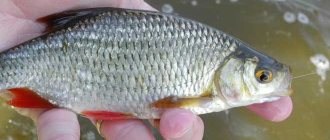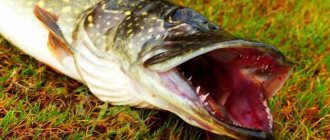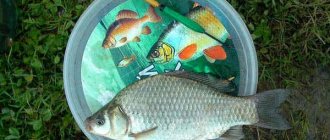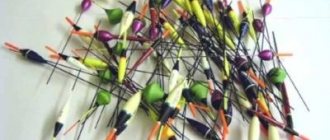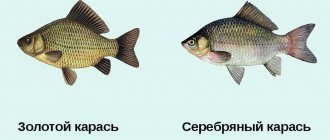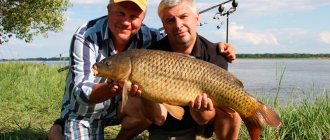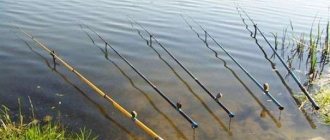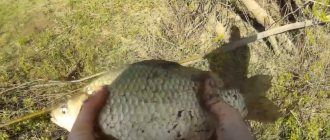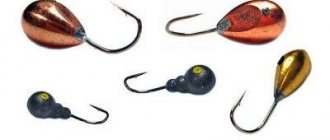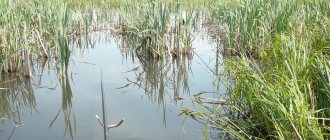Float fishing - what is it?
Float fishing is one of the most common fishing methods.
This type of fishing is also one of the most versatile. You can fish both from the shore and from a boat, depending on the terrain and the gear itself. The main and integral component of float fishing is the float rod. It consists of a rod, a reel (in most cases), fishing line or braid, a float (one of the most important parts of the tackle), a weight and a hook. Due to its length, the rod can deliver the bait to the place the fisherman needs, and the float serves as a bite alarm.
Float structure
Floats with thin tips are very sensitive to bites
Almost all floats consist of 3 parts:
- Frame.
- Antenna (signaling device).
- Keel.
The basis of any float is a body made of lightweight material that ensures its buoyancy. It can be balsa or any other material lighter than water. To ensure that the float stands vertically and is constantly in this position, it is equipped with a keel, which is made of heavier materials that sink in water. The antenna is a bite alarm and can be made of any materials. The main requirement for an antenna is to be visible at some distance from the fisherman. As a rule, the antenna is painted in bright colors. To attach the float to the main line, it may have guide rings. Floats can be attached at one or two points, depending on the type of float and its purpose. In this regard, there are floats that do not have an antenna or keel.
Floats can have the following body shapes:
- In the form of an olive. Floats of this type are called universal, which means that they can be used under various fishing conditions. It is stable on the surface of the water, in the presence of waves and ripples.
- Ball . Such floats, in their characteristics, are no different from the previous ones. They perform well in the presence of wind.
- Drop shape. These floats have a slightly shifted center of gravity downwards, making it more stable in the presence of disturbances on the surface of the water. They can fish in ponds and lakes at depths of more than one and a half meters.
- Inverted drop. This type of float allows you to fish at great depths, more than 3 meters with the presence of a current.
- In the form of a spindle. More suitable for fishing in still water, at depths of up to 3 meters. The float is quite sensitive and has proven itself well when catching cautious fish.
- The float is straight. Its very simple shape allows it to be used in calm weather on ponds and lakes where the depth does not exceed 2 meters.
- The float is flat. One of the most stable floats when fishing in currents. This float is similar to a disk on which an antenna with a keel is mounted, which is at an angle of 45 degrees.
Tackle for float fishing
As mentioned earlier, a float rod consists of several irreplaceable and important parts: a rod, a fishing line, a float and a weight with a hook. The rod delivers the bait to the part of the reservoir desired by the fisherman, the fishing line delivers the fish directly to the shore, the float is a signaling device, and the weight is installed to adjust the float and its convenient operation. A hook is also an integral part of any type of fishing. Let's look at the main components of float fishing in more detail.
Rod selection
A fly rod is the most primitive and ancient type of fishing rod. The coil does not attach to it. The fishing line and the equipment present on it are attached to the tip of the rod. The fly rod has a length of 5 to 10 meters on average. It is excellent for beginners as it does not require any special notes on use. Also, these fishing rods have very sensitive tips, which helps in hooking and fishing for fish.
A match rod is a composite or telescopic rod with a length of 5 to 7 meters. Its integral component is a reel - most often a spinning reel with a sufficient amount of fishing line on it. This fishing rod is used in most cases for fishing at depths, so it is in great demand among avid fishermen.
Bolognese rod - designed for fishing in currents, although it is also excellent for fishing in still water. The rod is telescopic and equipped with rings that guide the fishing line from the reel. Due to this technical component of the rod, you can skillfully handle the bait in the current and easily catch the fish that has bitten. Reels for this type of fishing rod are suitable both inertial and non-inertial.
A pole rod is an improved version of a fly rod. Typically its length varies from 8 to 20 meters. There is a sensitive shock absorber at the tip that helps dampen the jerking of the fish when playing. It is extremely popular as it allows you to fish at distances and depths far from the shore.
Line selection
The choice of fishing line is influenced by several important factors. First of all, you should pay attention to the expected production. If the angler’s goal is to catch a worthy specimen of whitefish, carp or predator, then the fishing line must be strong enough and thick. The ideal option would be a line size of at least 0.20mm, but it is recommended not to use a line thicker than 0.35mm, because this may spook the fish.
The choice of fishing line also depends on the time of year in which the fishing will be done. In spring and autumn, although the fish are hungry, they are very attentive and careful. At this time, you need to use a thinner line than in summer so that the fish have no reason to worry. In the summer, many species of fish are no longer so picky and sensitive. As the water warms, they become more active and approach the bait less cautiously. But it is always worth remembering that the choice of fishing line determines not only the fish’s interest in the bait, but also the outcome of its further fishing ashore. You should always keep a landing net with you
Leash
A leash is an integral part of fishing. Although this component is not mandatory, it should not be neglected. Leashes are most often placed below the float and corkscrew attached to the main line. Usually the leaders are made thinner than the main line so that the bait is less noticeable and the fish feel less alarm. It is recommended to choose a fishing line for the leash that is 0.2 - 0.5 mm smaller than the main one. It must be remembered that a good leash is the key to successful hooking and bringing the fish to shore.
Coil selection
Inertial - reels that are most often used for Bolognese and match fishing rods. These reels are not capable of casting tackle over long distances, so they are used only for unwinding the required length of fishing line. But it is worth noting that this type of coil is very reliable and easy to use.
Inertia-free reels are designed for many types of fishing, from spinning, feeder and ending with float. Such reels are often attached to match and Bolognese fishing rods. They are designed for fishing long distances from the shore and are very useful in the fight against large fish. Inertia-free coils have a more complex structure than inertial ones.
Choosing a float for fishing
Sliding floats are the most popular in float fishing. They do not require any special rules to use and do an excellent job. In order to bring this type of floats into working condition, you need to fix two corkscrews on the main fishing line. One is attached below the float and separates it from the weights, and the other is attached directly above the float and is its depth limiter. To change the depth, simply move the top corkscrew.
Main characteristics of floats
In general, there are only 3 main types of characteristics.
Loading
The most serious and significant characteristic of any float is the declared (official) weight of its total load. In most cases, the number itself is applied to the surface of the float and, most often, measured in grams - accordingly, this also indicates the total weight of the sinkers themselves, which must be used in combination with the current model of floats.
The weight mentioned above also has a full impact on many characteristics of the float itself. Thus, it is not difficult to guess that the greater the total weight of the sinkers needed to fully load the float itself, the larger the size of the float will be, and the smaller its total sensitivity will also be.
Sufficiently large floats are very often used for full-fledged fishing in reservoirs with strong currents, or at special depths, when it is necessary for the bait itself to also reach the very surface of the bottom as quickly as possible.
In order to catch fish in a reservoir with stagnant water with a load of about 2-3 grams are often used . and sometimes this value is even less. It all depends on the specific fishing conditions, as well as the fish that you intend to catch.
Thus, in order to catch crucian carp, bream, roach, it is necessary to use the lightest possible and, based on this, sensitive floats, the total load of which rarely exceeds 2 grams.
If you want to fish
in the current, floats with a higher load are used, the total weight of which very often cannot exceed 5 or 6 grams.
The float load for future casts , as well as for fishing in terms of retrieving, is approximately from 8 to 20 grams , again - everything directly depends on the fishing distance, current speed and many other conditions.
In addition, there are also so-called loaded floats, which have “their own weight” - that is, not feathers.
Quite often, all this is achieved through the use of small metal washers, which are located in the lower area of the float itself. At the request of the fishermen themselves, without much effort, they can increase or decrease their total number and thereby change the weight of the float.
Sensitivity
A good float for long-distance casting must be as stable as possible - that is, in fact, it should not lie on its side during strong gusts of wind or waves, it must be clearly visible, without taking into account the ripples themselves, and must be strong and not get wet.
All floats for this purpose, which fully satisfy all the above requirements, then you can be sure that any touch of a fish can lead to the fact that even the weakest touch of a fish will be signaled.
Antenna
The antennas on the floats are designed to fully improve the visibility of the float itself. Since the antennas are located directly above the surface of the water, then it does not affect the overall sensitivity of the floats, although it reduces the overall carrying capacity of the float itself.
An exception may be considered to be thick antennas that have positive buoyancy and do not at all reduce the overall sensitivity of the float itself.
Additional equipment
Additional equipment has saved many anglers more than once.
It not only increases the chance of catching a big fish, but also makes the fishing process easier:
- A fish tank is a convenient storage for caught fish. Cages are different. There are nylon, metal, wire. A distinctive feature of cages is the ability to keep caught fish fresh. It is enough to simply lower the fish tank into the water and secure it with a stag or rope. In water, the fish will feel better and remain fresh.
- A landing net is an integral part of any fishing. Regardless of whether you are fishing with a float rod or fishing with a feeder, the landing net should always be with the angler. With its help, you can bring the fish in at any time and bring it to the shore, rather than trying to do this with any sharp jerk or hands. The landing net has more than once saved the fisherman who was faced with the landing of large fish.
- The leader always helps the angler deliver hooks and leashes in good condition to the fishing site. It is always recommended to have such a thing on hand so that if the main gear breaks, you can replace it with a new one in time.
- Stands and slings are useful things for float and feeder fishing. It is much more convenient to place fishing rods on a good stand, which will protect it from dirt and in case of a strong bite, the fish will not be able to drag the tackle into the water. Also, stags are very unpretentious in storage. If you don’t want to use a store-bought stand, you can always make your own from scrap materials: wire, wood, twigs.
Float rod equipment
The equipment of a float rod is perhaps one of the most important factors influencing the success of fishing. So that the fish does not feel wary and the bite is pleasing, it is necessary to take a responsible approach to assembling the float.
THE BEST and SIMPLE FLOAT EQUIPMENT for CRUCCIAN
Let's look at this assembly step by step, taking as an example a standard Bolognese fishing rod, an inertial reel, a 0.20 mm fishing line, a 5 gram float, a weight and a number 18 hook:
- The first step is to attach the reel to the rod itself. To do this, you need to unscrew the grooves and then attach the coil, carefully tightening it later.
Next comes a more important step - winding the fishing line onto the reel. It is advisable to have extra fishing line in reserve, since in the event of a break, the fisherman will be saved by this spare excess thread and he can safely continue fishing. It is necessary to tie a knot on the reel itself, and then begin to wind the fishing line while holding it in a weak tension. It is important that the fishing line lies neatly and evenly. After the supply of fishing line has been wound onto the reel, you need to thread its end through the rings of the rod.- When you have finished applying the line to the reel, you need to start installing the float. Here you need to take into account what type of float will be used: fixed or sliding. An example would be the installation of a sliding float. First you need to smoothly put a corkscrew on the fishing line, which will serve in the future as a kind of limiter for the float. It attaches easily, without any problems. Then you should put a float on the fishing line, followed by another corkscrew (however, it is not necessary to put on a second corkscrew).
- The next step is to attach the sinkers and hook. The weights must be attached so much that their total weight does not exceed the weight of the float. In this case, no more than five grams. When the load is in place, you should add the finishing touch - tie a hook to the fishing line. There are a huge number of nodes, so a specific fastening is not necessary. The main thing is that the knot is strong and not bulky. It is also worth making sure that when tying a knot, the fishing line does not burn out as a result of friction. To do this, you first need to moisten it with water, and then carefully tighten it, checking the knot for strength and appearance.
With these few simple steps, a good-quality telescopic float fishing rod was ready, which can very well show decent fishing results. It is important that all parts of the fishing rod are attached to each other as expected, and it is also necessary to check the condition of the gear after each fishing trip. If all the conditions are met, then, of course, fishing will show only positive results and will bring a lot of emotions.
Choosing bait for float fishing
There are a huge variety of baits that can show very good results. The baits used for float fishing have several differences from bottom baits. For example, many of them can be made not so heavy, because near the shore the current is not so strong and the bait will not be carried throughout the entire reservoir. Also, the water area near the shore is much easier than making a lot of feedings using a feeder at a distance far from the shore. Nevertheless, let’s look at the main types of bait:
Groundbaits in still water are often made from larger, less heavy components. If there is no current, the fertilizer will not spread throughout the reservoir. This allows you to make bait from light cereals (rice, pearl barley), bran, barley, as well as crushed grains. The porridge is boiled, and then, when it has cooled, chopped worms are added or simply flavored with vanilla, anise, and garlic. However, it should be remembered that excessively strong odors can scare away fish, so you need to be careful when using spices.- Bait in the current is done a little differently. To prevent the fertilizer from being knocked down by the current and carried to the other end of the reservoir, it is necessary to add heavier components to it and create some kind of solid mass. For example, during float fishing on rivers with a current, the following bait is used: river clay with sand, chopped worms, maggots and corn are taken in a ratio of 50 - 60% to 20% and 10%. Corn is the least common, since in some cases it is the main bait. The fish should not be fed with it. Due to the clay, this bait will have a strong consistency and will not be immediately carried away by the current, having lain for some time at the bottom.
- Store-bought bait is a very good choice for a novice fisherman. Since not all beginners are able to produce high-quality bait, ready-made store-bought food can come to their aid. There are a huge number of them, but in practice they all show very excellent results. An example is the favorite bait of many fishermen - “Tutti-Frutti”. It contains everything that fish love so much: corn, oatmeal, breadcrumbs, vanilla and much more. This feeding has shown excellent results in practice, which have been undeniable over the years.
DIY bait is perhaps the most popular type of bait. Every fisherman, regardless of his financial component, can take advantage of them and create the very bait that will ultimately show itself with a bang! What can be included in homemade bait? Everything! You can use porridge, bran, crushed grain. Homemade dill, garlic, sugar or everyone’s favorite vanilla are suitable as seasonings and spices. The simplest recipe is boiled porridge with the addition of vanilla and crackers. You also need to pay attention to the consistency and choose one that is suitable for the body of water where you plan to fish.
Choosing bait is a responsible task on which the upcoming fishing depends.
Bait in float fishing
Every year the approach to complementary feeding strategies and formulations becomes more and more careful. Many fishermen have abandoned store-bought mixtures, having learned to make their own secret ones that give excellent results. But in the hustle and bustle of life, you don’t always have the time and energy to make complementary foods yourself - it is very convenient to buy bait in a store, where prices vary widely. And one mixture can cost 5-6 times more than another. So the most expensive one is six times better at attracting and holding fish than the cheapest one? It is significant that even some of those who sell bait mixtures and often go fishing themselves admit that a reasonable price per kilogram of the mixture is in the region of 150 - 200 rubles, especially when fishing for bream, chub, ide, and silver bream. Only for large roach, very capricious crucian carp, more expensive bait can give a great additional effect, and only when it is successfully selected and served, which can only be calculated experimentally. Floaters also have a lot of questions for domestic bait manufacturers - the food seems to be good, and more or less priced, but why do the manufacturers themselves talk little about the working properties of their bait mixtures, the results of fishing in reservoirs at different times of the year, and what additives these mixtures are compatible with? etc.
Fishing with a float - technique and tactics
Choosing a location is a significant process that determines the success of fishing. Experienced fishermen cope with this task quickly. Beginners are advised to look for places with abundant surface vegetation (reeds, willows) and relatively shallow depths.
Fishing technique also affects the success of fishing. Before you start fishing, you need to decide how exactly the fishing will be done. Beginner fishermen are recommended to first get acquainted with fly and Bolognese rods. They are easy to use and will not cause problems. Don't chase depths. It is enough to fish 8 - 12 meters from the shore. This is often how you meet the fish of your dreams.
You need to fish in the current with the necessary equipment. It is necessary to use heavier weights and equip fishing rods with floats for fishing in the current. Also, if the bait that the angler uses while fishing is carried away by the current, you need to change its consistency.
Fishing from the shore is always more comfortable. Unlike fishing on a boat, on the shore everything you need is always at hand. Fishing rods can be placed on stands, and in case of a bite from a large fish there will always be support.
Fishing in still water always pleases fishermen with its tranquility and excellent catch. It’s much more pleasant to fish in still water, and it’s also worth noting that any bait is suitable for still water. The main thing here will be not to overdo it with flavorings, because the smell will be incredibly persistent in the absence of flow.
Fishing near the reeds is popular among many anglers. It is in places where the shore is overgrown with reeds that the bite is often much better than in bare places. But the best option would be fishing in reed windows. Such places are rare, but you can make them yourself by trampling or mowing part of the reeds. In such treasured gaps you can often get trophy carp or large crucian carp.
Fishing from a boat must be done responsibly. It is enough to sail 10 - 15 meters from the shore, measuring the depth. Some fishermen, not wanting to make holes in the reeds, simply use a boat to get across the water to the reeds and begin fishing near the vegetation. Before sailing, you should carefully check the boat.
Landing fish is an important part of fishing. When a medium-sized crucian carp from 400 to 900 grams is on the hook, pulling it out will not be difficult. But when specimens heavier than 1.5 kg are encountered, the fishing tactics must change. You should not suddenly try to pull the fish out of the water. You need to tire her out by letting go of the line a little at times. Then the landing net comes into play, without which fishing is simply impossible.
This includes the most significant fishing tips that will help even a beginner feel the resistance of the fish for the first time and carry out his fishing safely.
Features of float fishing at different times of the year
At different times of the year, the behavior of fish changes. For fishing to be successful, you need to know its habits and use them to your advantage:
In spring, most fish species try to gain strength and actively feed on everything they can find. Spring is the most successful time for fishing with a float rod. At this time, fish species such as crucian carp, carp, and carp come close to the shore and look for areas most warmed by the sun. Such places will undoubtedly bring a big catch.- In summer, fishing is not as vibrant as in spring. This is due to the fact that it gradually becomes hot and the fish, having spawned and fattened, see no point in being near the shore. She goes deep. In the summer, the most appropriate option would be fishing on a feeder. Vegetable baits are preferred.
- In the fall, the fish begin to feed again. Occasionally you can see small schools of crucian carp approaching the shore. However, preference should still be given to feeder and spinning fishing. Float fishing can also show good results if you find a good hole in the reeds and feed the place.
No matter what time of year you use float fishing, you should always pay attention to the habits of the fish, their preferences, the weather, as well as the characteristics of certain bodies of water.
Float fishing is a great way to spend time in comfort.
It is worth noting that this is the most ancient and reliable method of fishing, proven over centuries. The functionality of the float rod is always at the highest level, and its maintenance will not require you to waste much effort. This is exactly the tackle that can fish both in the shallows and at depth with maximum comfort. Fishing at dawn with a float. The bite of crucian carp on a fly rod.
Flying rod boom
The last year or two has been marked by a real boom in the fly fishing rod, some see it as a radical novelty for themselves, others remind us that these are the origins of the float - before, everyone used to fish without any reels with equipment equal to the length of the rod. Basically, the novelty is only in length; from 4-5 m there was an active transition to 6-7 m of light, rigid carbon fiber. Most fans of fly fishing rods are inclined towards 6 m rather than 7 m - it is much more pleasant to work with a shorter rod, hour after hour, without letting it out of your hands, and they are also more versatile. Many skilled float fishermen convert such fishing rods to jig rods right on the pond, attaching a special nod to the tip, and when the fish moves away from the banks, they return the float equipment to its place.
And in quarries at promising depths adjacent to the shores, the fly rod works as a feast for the eyes. It’s convenient to fish with sixes or sevens without rings, because the depth increases right near the shore, and large fish often come here. And you can catch fish without any problems - the long blank absorbs well, the prey walks back and forth and is successfully caught. And many fishermen, looking at this, switch from lapdogs to a lighter swing.
It is in fly fishing that there is a noticeable transition to carbon fiber - it is profitable to invest in a good, high-quality rod if a reel is not needed.
